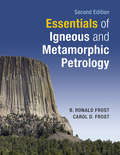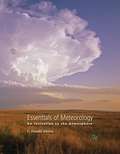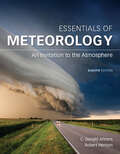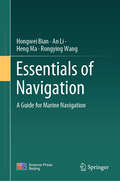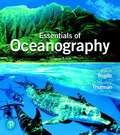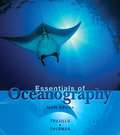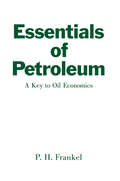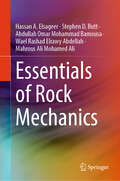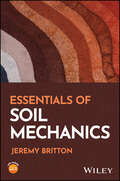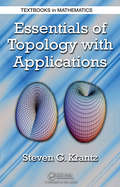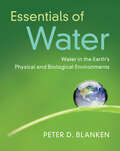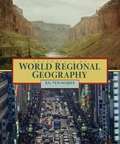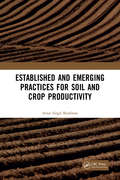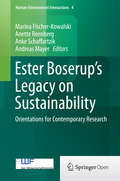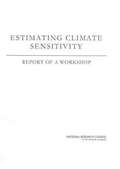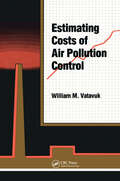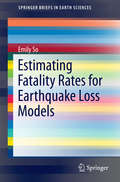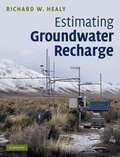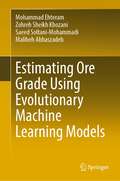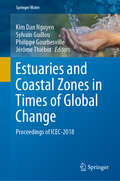- Table View
- List View
Essentials of Igneous and Metamorphic Petrology
by B. Ronald Frost Carol D. FrostAll geoscience students need to understand the origins, environments and basic processes that produce igneous and metamorphic rocks. This concise textbook, written specifically for one-semester undergraduate courses, provides students with the key information they need to understand these processes. Topics are organized around the types of rocks to expect in a given tectonic environment, rather than around rock classifications: this is much more interesting and engaging for students, as it applies petrology to real geologic environments. This textbook includes over 250 illustrations and photos, and is supplemented by additional color photomicrographs made freely available online. Application boxes throughout the text encourage students to consider how petrology connects to wider aspects of geology, including economic geology, geologic hazards and geophysics. End-of-chapter exercises allow students to apply the concepts they have learnt and practice interpreting petrologic data.
Essentials of Igneous and Metamorphic Petrology
by B. Ronald Frost Carol D. FrostAll Earth Science students need to understand the origins, environments, and basic processes that produce igneous and metamorphic rocks. This concise introductory textbook provides students with the essential knowledge needed to understand how petrology relates to other topics in the geologic sciences, and has been written specifically for one-semester courses. Throughout, the emphasis is on interpreting the mineralogy and petrology of rock suites in terms of origin and environment, with the first half of the book concentrating on igneous rocks, and the second half on metamorphic rocks. This Second Edition has been thoroughly revised and brought completely up-to-date. It now includes a new chapter on the application of stable and radiogenic isotopes in petrology, introducing students to the concept of isotopic fractionation and describing the process of radioactive decay. The discussions of phase diagrams, connections between igneous and metamorphic rock suites, and convergent margin magmatism have also been expanded. There is a new glossary of terms, updated end-of-chapter exercises, and updated further readings.
Essentials of Medical Geology
by Olle Selinus Brian Alloway Jose Centeno Pauline Smedley Robert Finkelman Ron Fuge Ulf LindhEssentials of Medical Geology reviews the essential concepts and practical tools required to tackle environmental and public health problems. It is organized into four main sections. The first section deals with the fundamentals of environmental biology, the natural and anthropogenic sources of health elements that impact health and illustrate key biogeochemical transformations. The second section looks at the geological processes influencing human exposure to specific elements, such as radon, arsenic, fluorine, selenium and iodine. The third section presents the concepts and techniques of pathology, toxicology and epidemiology that underpin investigations into the human health effects of exposure to naturally occurring elements. The last section provides a toolbox of analytical approaches to environmental research and medical geology investigations. Essentials of Medical Geology was first published in 2005 and has since won three prestigious rewards. The book has been recognized as a key book in both medical and geology fields and is widely used as textbook and reference book in these fields. For this revised edition, editors and authors have updated the content that evolved a lot during 2005 and added two new chapters, on public health, and agriculture and health. This updated volume can now continue to be used as a textbook and reference book for all who are interested in this important topic and its impacts the health and wellbeing of many millions of people all over the world. · Addresses key topics at the intersection of environmental science and human health · Developed by 60 international experts from 20 countries and edited by professionals from the International Medical Geology Association (IMGA) · Written in non-technical language for a broad spectrum of readers, ranging from students and professional researchers to policymakers and the general public · Includes color illustrations throughout, references for further investigation and other aids to the reader
Essentials of Medical Meteorology
by Vlado Spiridonov Mladjen Ćurić Oliver ZafirovskiThis book discusses the impacts that weather and climate have on human physical health, longevity, and mental wellness, and acts as a guide to the application of meteorological science in health care. It provides a background on biometeorology by covering basic concepts of human anatomy and meteorology, and how modern biometeorological science can be incorporated into medical practice through diagnosis, prevention and treatment of physical and mental diseases. The recommendations, advice and preventive measures addressed in this book aim to help people adapt to different weather phenomena and changes to minimize negative health consequences, which is increasingly relevant as climate change and its effects on human health become more pronounced and studied. The book is intended for environmental epidemiologists, medical students, physicians, health care providers, climate scientists, insurance industries and policy makers, but will also appeal to general enthusiasts of atmospheric, climate and medical sciences.
Essentials of Meteorology: An Invitation to the Atmosphere
by C. Donald AhrensThis updated and enhanced seventh edition of ESSENTIALS OF METEOROLOGY is written by the most widely read and authoritative author in introductory meteorology-Donald Ahrens. Ahrens's ability to explain relatively complicated ideas in a student-friendly, manageable fashion allows even non-science students to visualize the principles of meteorology. The text's clear and inviting narrative is supplemented by numerous pedagogical features that encourage observing, calculating, and synthesizing information. New critical thinking questions linked to key figures and concept animation boxes point to online animations and appendices allowing students to immediately apply the text material to the world around them--and understand the underlying meteorological principles.
Essentials of Meteorology: An Invitation to the Atmosphere (Mindtap Course List Series)
by Robert Henson C. Donald AhrensESSENTIALS OF METEOROLOGY, 8th Edition, is written for students interested in gaining insights into the dynamic workings of the atmosphere. The authors' ability to explain relatively complicated ideas in an easy-to-understand way lets both science and nonscience majors visualize the principles of meteorology.
Essentials of Navigation: A Guide for Marine Navigation
by An Li Hongwei Bian Heng Ma Rongying WangThis book gives a basic introduction to navigation, from key concepts, basic principles, main technologies, equipment systems to the knowledge frame of navigation. The ten chapters fall into three parts: Chapters I~III introduce the elementary knowledge of navigation; Chapters IV~IX are devoted to the basic principles, and the optimization principle of integrated navigation as well; and Chapter X discusses the application of marine navigation, indicating the basic outline of the marine navigation system. The book clearly reflects the systematic idea of navigation knowledge from multiple perspectives, which is helpful for readers to build a holistic understanding of navigation from the concept, principle, characteristics, technology to the equipment system. At the end of each chapter, reflections beyond the fundamental knowledge of navigation are included to help readers further develop their scientific thinking and general literacy. This book is written primarily for students majoring in navigation, and it may also be of interest to researchers and practitioners engaged in navigation.
Essentials of Oceanography
by Harold V. Thurman Alan P. TrujilloAs the bestselling brief book in the oceanography market, Essentials of Oceanography combines dynamic visuals and a student-friendly narrative to bring oceanography to life. The text’s engaging features and the extensive suite of animations and videos keep students interested and excited about the material. <p><p> The 13th Edition creates an interactive learning experience that provides tightly integrated text and digital offerings to make oceanography approachable and digestible for students. An emphasis on the process of science throughout the text provides students with an understanding of how scientists think and work. The new edition also helps students develop the scientific skill of practicing and interpreting data with new Exploring Data features supported by Mastering Oceanography coaching activities. A new Creature Feature provides fun facts about marine animals to engage students.
Essentials of Oceanography (10th edition)
by Harold V. Thurman Alan P. TrujilloTrujillo and Thurman present in-depth discussions of oceanographic concepts and demystify the science even for non-science students. Their systems approach highlights the relationship between oceanographic phenomena and how those phenomena affect other Earth systems. Scientific information from geology, chemistry, physics, and biology combine to illustrate how each of these disciplines relates to the ocean.
Essentials of Petroleum
by Paul H. FrankelPublished in the year 1969, Essentials of Petroleum is a valuable contribution to the field of Geography.
Essentials of Rock Mechanics
by Hassan A. Elsageer Stephen D. Butt Abdullah Omar Mohammad Bamousa Wael Rashad Abdellah Mahrous Ali AliThis book extensively covers rock mechanics and engineering, playing a vital role in mining, geological, and civil applications. It explores the stability, failure, and behavior of rock masses, offering control and prediction methods. Fundamental concepts, stress and strain analyses, failure theories, and rock characteristics are addressed, essential for safety in mining and construction. Applications like geological hazard assessment, slope stability, and foundation design demonstrate its significance in civil and geological engineering. The book's structured approach includes an overview in Chapter 1, stress analyses in Chapter 2, and plane strain analyses in Chapter 3. Subsequent chapters delve into rock behavior, failure theories, and specific properties. Practical aspects, such as designing underground openings, are covered in later chapters. The incorporation of numerous solved tutorials enhances its value for students and educators seeking a comprehensive understanding of these pivotal topics.
Essentials of Soil Mechanics
by Jeremy BrittonAn overview of the key foundations of soil mechanics Geotechnical engineering is the subfield of civil engineering which specifically deals with the behavior of earth materials, such as soil and rocks. Soil mechanics is an essential component of geotechnical engineering, and one which incorporates geology, hydrogeology, and other connected subjects in an interdisciplinary engineering approach. Since geotechnical engineering remains a vital component of civil engineering, the need for good introductory materials on soil mechanics continues to be urgent. Essentials of Soil Mechanics meets this need with a concise, readable introduction to soil behavior and the engineering properties of soil. Written by a practicing engineer with a passion for teaching, it emphasizes content that is used on a regular basis and equips engineers to find additional information they may need. It is an essential reference and supplement for anyone needing additional guidance on this crucial subject. Essentials of Soil Mechanics readers will also find: A friendly, engaging, accessible tone throughoutDetailed discussion of topics including effective stress, seepage, consolidation, shear strength, and moreRecaps at the end of each chapter to emphasize key concepts Essentials of Soil Mechanics is ideal for students studying soil mechanics, geotechnical engineering, civil engineering, and related subjects.
Essentials of Topology with Applications (Textbooks in Mathematics)
by Steven G. KrantzBrings Readers Up to Speed in This Important and Rapidly Growing AreaSupported by many examples in mathematics, physics, economics, engineering, and other disciplines, Essentials of Topology with Applications provides a clear, insightful, and thorough introduction to the basics of modern topology. It presents the traditional concepts of topological
Essentials of Water: Water in the Earth's Physical and Biological Environments
by Peter BlankenWater shapes the planet and all life upon it. Breaking down traditional disciplinary barriers, this accessible, holistic introduction to the role and importance of water in Earth's physical and biological environments assumes no prior knowledge. It provides the reader with a clear and coherent explanation of the unique properties of water and how these allow it to affect landscapes and underpin all life on Earth. Contemporary issues surrounding water quality – such as the rise of microplastics and climate change – are highlighted, ensuring readers understand current debates. Giving all of the necessary background and up-to-date references, and including numerous examples and illustrations to explain concepts, worked mathematical calculations, and extensive end-of-chapter questions, this is the ideal introductory textbook for students seeking to understand the inextricable links between water and the environment.
Essentials of World Regional Geography (4th edition)
by Christopher L. Salter Joseph J. HobbsKit Salter and Joe Hobbs build the story of each region using contemporary concerns, global issues, and historical themes to create a complete picture of our ever-changing planet and its people.
Essentials of the Earth's Climate System
by Roger G. Barry Eileen A. Hall-McKimThis concise introduction to modern climatology covers the key topics for intermediate undergraduate students on one-semester courses. The treatment of topics is non-mathematical wherever possible, instead focusing on physical processes to allow students to grasp concepts more easily. Full-color illustrations support the text and supplementary topics are covered in boxes, enabling students to further increase their knowledge and awareness. A historical perspective of climatology is woven throughout, providing students with an insight into key scientists and technological developments. Each chapter concludes with a summary of the main points and a mixture of review and discussion questions, encouraging students to check their understanding and think critically. A list of key web links to data and other resources, and solutions and hints to answers to the student questions (password-protected for instructors) are provided online to complete the teaching package.
Established and Emerging Practices for Soil and Crop Productivity
by Avtar Singh BimbrawThe book explains the various existing, emerging and environmentally viable technologies for the sustainable and profitable crop productivity. The book also focusses on climate change, hurricanes and tropical storms, natural resources management, crop diversification, crop resource management, cropping systems, farming system, management of land use resources, conservation agriculture, crop residue management, renewable energy, precision agriculture, integrated nutrient management, integrated pest management.Note: T&F does not sell or distribute the Hardback in India, Pakistan, Nepal, Bhutan, Bangladesh and Sri Lanka.
Establishing Plus-Minus-Energy-Regions: The Maluku Archipelago in Indonesia
by Dieter D. Genske Giovanni Maurice PradiptaThis book explains and illustrates how Indonesia as the largest and most populous country in Southeast Asia can become independent of fossil fuels by both reducing its energy needs and using renewable resources. A study presented in this work focuses on the Maluku Archipelago in eastern Indonesia with Ambon as its capital. Conventional energy is brought to the islands over long distances by partly simple means as boats, ships and aircrafts. This unsustainable situation calls for a decentralized renewable energy supply strategy. Based on the research presented in this book, it is clear that the archipelago has the potential to become a so-called plus-minus region. Plus-minus regions are regions that produce more renewable energy than they need and capture more CO2 than they emit. The authors are convinced that the presented strategy illustrated on the Maluku Archipelago can be transferred to other regions of the world and that only by developing plus-minus regions the international 2°C climate goal can be achieved. The model region thus serves as proof that the plus-minus target can also be achieved in emerging countries with limited financial resources.
Ester Boserup's Legacy on Sustainability
by Andreas Mayer Marina Fischer-Kowalski Anette Reenberg Anke SchaffartzikArising from a scientific conference marking the 100th anniversary of her birth, this book honors the life and work of the social scientist and diplomat Ester Boserup, who blazed new trails in her interdisciplinary approach to development and sustainability.
Estimating Climate Sensitivity: Report Of A Workshop
by Board on Atmospheric Sciences Climate“Climate sensitivity” is a term used to characterize the response of the climate system to an imposed forcing, and is most commonly used to mean the equilibrium global mean surface temperature change that occurs in response to a doubling of atmospheric carbon dioxide concentration. The purpose of this workshop was to explore current capabilities and limitations in quantifying climate sensitivity and consider whether there are alternative approaches for characterizing climate response that might better suit the information needs of policy makers.
Estimating Costs of Air Pollution Control
by William M. VatavukIn these pages is all the information that you-manager, engineer, or other technical professional-would need to select, size, and estimate "budget/study" level capital and annual costs for a variety of air pollution control equipment. This equipment includes wet scrubbers, carbon adsorbers, and other "add-on" devices. This book also deals with such nonstack controls as wet dust suppression systems and flue gas desulfurization systems. The costs are current (1988 or 1989 dollars) and are mainly presented in equational form for ease of computerization and updating. Clear, comprehensive equipment sizing procedures are also detailed. Finally, several detailed example problems are included to illustrate the sizing and costing procedures. This book is not just for technical personnel, however. The material is easy to grasp and use. Anyone with an air pollution control background can follow and apply the procedures and data herein. Using this book, air pollution control professionals can now develop sound, defensible (within ±30%) cost estimates with a minimum of time and effort.
Estimating Fatality Rates for Earthquake Loss Models
by Emily SoThis manuscript sets out a process for estimating fatalities in collapsed buildings due to ground shaking in an earthquake. The aim of this research is to supplement current earthquake loss estimation with fatality rates (percentage of occupants killed) for use in models which are based on recent empirical information on deaths from earthquakes. This document specifically explores the lethality potential to occupants of collapsed structures. Whilst earthquake casualty modeling has admittedly suffered from a lack of post-earthquake collection of data and rigour in assessing these data, recent earthquakes such as 2008 Wenchuan (China) and 2011 Christchurch (New Zealand) have brought to light some important findings. Under the auspices of US Geological Survey's PAGER, empirical fatality data related to collapses of buildings from significant earthquakes in the past 40 years have been thoroughly examined. Through detailed investigations of fatal building collapses and the volume reductions within these buildings, important clues related to the lethality potential of different failure mechanisms of global modern and older construction types were found. The gathered evidence forms the basis of the derivation of a set of fatality rates for use in loss models. The set of judgment-based rates are for 31 global building types. This significant advancement in casualty modeling, the resolutions and quality of available data, the important assumptions made, and the final derivation of fatality rates are discussed here. This document contributes to global efforts to develop a way of estimating probable earthquake fatalities very rapidly after an earthquake has taken place. The fatality rates proposed here can be incorporated directly into earthquake loss estimation models where fatalities are derived from collapses of different types of buildings.
Estimating Groundwater Recharge
by Richard W. Healy Bridget R. ScanlonUnderstanding groundwater recharge is essential for successful management of water resources and modeling fluid and contaminant transport within the subsurface. This book provides a critical evaluation of the theory and assumptions that underlie methods for estimating rates of groundwater recharge. Detailed explanations of the methods are provided - allowing readers to apply many of the techniques themselves without needing to consult additional references. Numerous practical examples highlight benefits and limitations of each method. Approximately 900 references allow advanced practitioners to pursue additional information on any method. For the first time, theoretical and practical considerations for selecting and applying methods for estimating groundwater recharge are covered in a single volume with uniform presentation. Hydrogeologists, water-resource specialists, civil and agricultural engineers, earth and environmental scientists and agronomists will benefit from this informative and practical book, which is also a useful adjunct text for advanced courses in groundwater or hydrogeology.
Estimating Ore Grade Using Evolutionary Machine Learning Models
by Mohammad Ehteram Zohreh Sheikh Khozani Saeed Soltani-Mohammadi Maliheh AbbaszadehThis book examines the abilities of new machine learning models for predicting ore grade in mining engineering. A variety of case studies are examined in this book. A motivation for preparing this book was the absence of robust models for estimating ore grade. Models of current books can also be used for the different sciences because they have high capabilities for estimating different variables. Mining engineers can use the book to determine the ore grade accurately. This book helps identify mineral-rich regions for exploration and exploitation. Exploration costs can be decreased by using the models in the current book. In this book, the author discusses the new concepts in mining engineering, such as uncertainty in ore grade modeling. Ensemble models are presented in this book to estimate ore grade. In the book, readers learn how to construct advanced machine learning models for estimating ore grade. The authors of this book present advanced and hybrid models used to estimate ore grade instead of the classic methods such as kriging. The current book can be used as a comprehensive handbook for estimating ore grades. Industrial managers and modelers can use the models of the current books. Each level of ore grade modeling is explained in the book. In this book, advanced optimizers are presented to train machine learning models. Therefore, the book can also be used by modelers in other fields. The main motivation of this book is to address previous shortcomings in the modeling process of ore grades. The scope of this book includes mining engineering, soft computing models, and artificial intelligence.
Estuaries and Coastal Zones in Times of Global Change: Proceedings of ICEC-2018 (Springer Water)
by Philippe Gourbesville Kim Dan Nguyen Sylvain Guillou Jérôme ThiébotThis book is a collection of extended papers based on presentations given during the ICEC 2018 conference, held in Caen, France, in August 2018. It explores both the limitations and advantages of current models, and highlights the latest developments concerning new numerical schemes, high-performance computing, multi-physics and multi-scale methods, and better interaction with field or scale model data. Accordingly, it addresses the interests of practitioners, stakeholders, researchers, and engineers active in this field.

